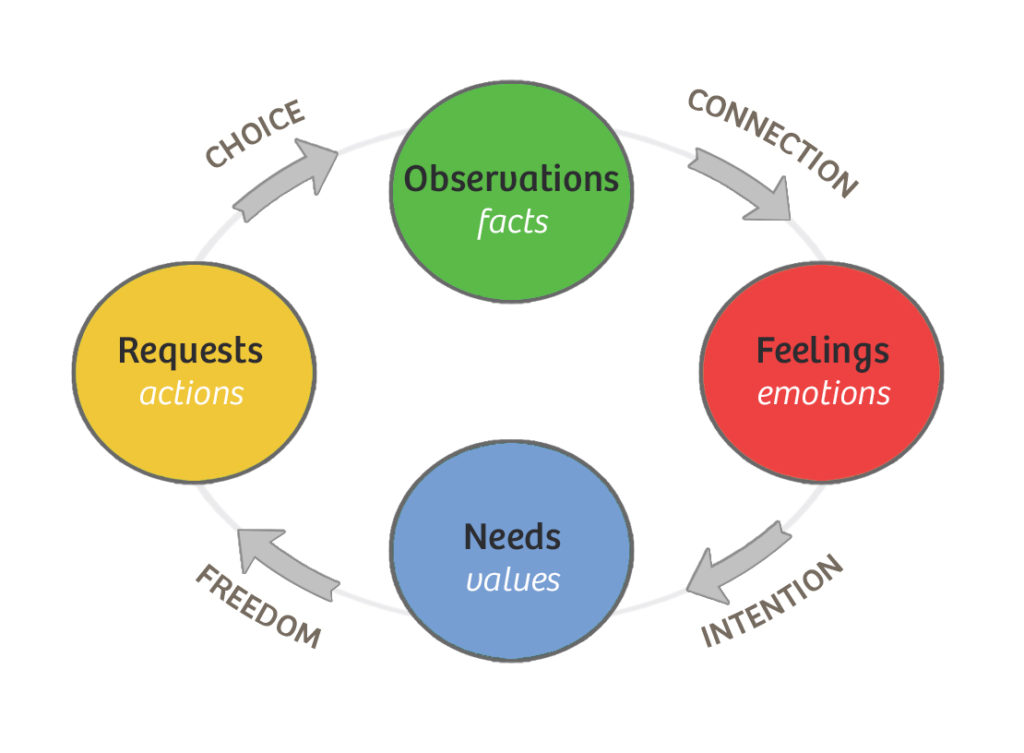What It Is:
Nonviolent Communication (NVC), also known as Compassionate Communication, was developed by psychologist Marshall B. Rosenberg. He introduced the concept in the 1960s as a communication process designed to facilitate compassionate understanding and connection between individuals, even in the midst of conflicts. The approach is grounded in principles of empathy, honesty, and a focus on needs rather than demands.
Key Components of Nonviolent Communication:
- Observation:
- Describing observable facts without judgment or evaluation.
- Feeling:
- Identifying and expressing one’s feelings without attributing them to others.
- Need:
- Recognizing and expressing underlying human needs or values.
- Request:
- Making clear, concrete requests that are actionable and not demands.
How to Use It:
Using Nonviolent Communication in Agile Coaching:
- Conflict Resolution:
- NVC provides a structured approach to resolving conflicts. As an Agile coach, you can guide team members in using NVC to express their observations, feelings, needs, and requests when conflicts arise.
- Effective Communication:
- Foster effective and empathetic communication within the team. Encourage team members to use NVC principles to express themselves clearly while considering the needs and feelings of others.
- Feedback Sessions:
- Integrate NVC into feedback sessions. When providing feedback, encourage team members to use nonviolent communication to ensure that feedback is constructive and focused on observations, feelings, needs, and requests.
- Building Empathy:
- NVC emphasizes empathy, both in understanding oneself and others. Facilitate empathy-building exercises within the team to enhance mutual understanding and collaboration.
- Creating a Safe Environment:
- NVC contributes to creating a psychologically safe environment where team members feel comfortable expressing themselves authentically without fear of judgment. This is crucial for Agile teams to promote open communication.
Nonviolent Communication is a valuable tool for fostering understanding, collaboration, and empathy within Agile software delivery teams. By incorporating NVC principles into coaching practices, you contribute to a positive and communicative team culture.
References:
- “Nonviolent Communication: A Language of Life” by Marshall B. Rosenberg:
- Marshall Rosenberg’s book is a comprehensive guide to Nonviolent Communication. It provides practical insights, examples, and exercises for applying NVC in various contexts.
- Workshops and Training Programs:
- Attend NVC workshops or training programs to deepen your understanding and practice of the communication process. Many trainers offer NVC courses for individuals and organizations.
- Online Resources and Videos:
- Explore online resources, videos, and interviews featuring Marshall Rosenberg and other NVC practitioners. These can provide additional perspectives and practical examples.
- NVC Organizations and Communities:
- Connect with organizations and communities dedicated to Nonviolent Communication. These communities often offer resources, forums, and events to support individuals in their NVC journey.
- Practice Groups:
- Join or initiate NVC practice groups where team members can regularly practice and integrate nonviolent communication principles. This hands-on approach helps reinforce the learning within the team.
Visit the Agile Coach’s Toolkit for more definitions, models, theorems and stuff.
